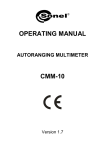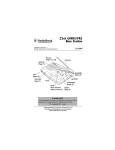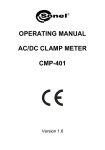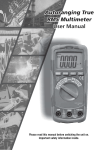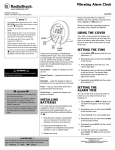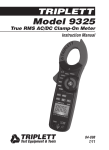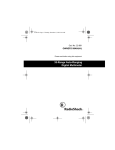Download Radio Shack 22-813 Owner`s manual
Transcript
www.radioshack.comSM 29-Range Auto/Manual Digital Multimeter OWNER’S MANUAL — Completely read this manual before using this meter. 22-813 Bar Graph Display – makes nulls, peaks, and trends more apparent. Auto-Ranging with ManualRanging Override – the meter automatically selects a range when you measure voltage, current, or resistance. You can also manually set the range when measuring values you know are within a certain range. Function Dial Latest IC and Display Technology – ensures reliability, accuracy, stability, and ease of operation. Data Hold Function – The meter holds the displayed value, so you can see the reading even after you disconnect the test leads. ! IMPORTANT ! If an icon appears at the end of a paragraph, go to the box on that page with the corresponding icon for pertinent information. — Warning ! — Important — CautionÓ Ô — Note o © 2002 RadioShack Corporation. All Rights Reserved. RadioShack and RadioShack.com are trademarks used by RadioShack Corporation. CONTENTS A Word About Safety A Word About Safety ..... 2 Safety Marks ................. 4 Preparation .................... 5 Installing Batteries ..... 5 Connecting the Test Leads ................. 5 Operation ...................... 6 Taking Accurate Measurements ........... 6 Turning the Meter On/Off and Testing the Display .... 6 Before You Start ......... 7 Holding a Measurement ............. 9 Automatic Power Off ................. 10 Using Power Lock .............. 10 Using the Bar Graph ................. 11 Making Measurements ............ 12 Measuring DC/AC Voltage ........ 12 Measuring DC/AC Current ........ 14 Measuring Resistance ............... 15 Checking Continuity ................. 16 Checking Diodes ..... 17 Checking Batteries .................. 18 Care ............................ 20 Cleaning .................. 20 Replacing the Fuse .. 20 Specifications .............. 21 2 Thank you for buying a RadioShack 29Range Auto/Manual Digital Multimeter. Your multimeter is a portable, compact autoranging digital multimeter. It is ideally suited for field, lab, shop, and home applications. The multimeter provides accurate measurements and is built to provide the highest possible reliability. The meter measures DC and AC voltage up to 600V, DC and AC current up to 10A, resistance up to 40MΩ, and tests 1.5V C, D, AA, AAA, and 9V batteries. Its 33/4-digit digital display can show up to 4,000 units. Its bar graph display appears with the digital display to let you easily see nulls, peaks, and trends. A WORD ABOUT SAFETY We have taken every precaution in designing this meter to ensure that it is safe. Safe operation depends on you, the operator. We recommend that you follow these simple safety rules. • This equipment is rated for installation category II (max. 3600 VA). • Never apply voltages to the meter that exceed the limits given in the specifications. Never apply more than 600V DC or AC between the input jacks and ground. • Use extreme caution when working with voltages above 30V RMS and 42.4V peak or 60V DC. Always disconnect power from the circuit you are measuring before you connect test leads to high-voltage points. • Never connect to a voltage source when you select the diode check, • • • • This meter is fully calibrated and tested. Under normal use, no further adjustment should be necessary. If the meter requires repair, do not try to adjust it yourself. Take it Ô to your local RadioShack store. o The UL mark does not indicate that this product has been evaluated by Underwriters Laboratories for the accuracy of its readings. • Your meter requires three AAA batteries (not supplied). Your meter also has these additional features. Auto Power Off — the meter turns itself off after about 30 minutes if you do not change any setting, helping conserve battery power. Auto-Polarity Operation — protects your meter and gives valid measurements when you connect the leads in reverse polarity. • • o WARNING o USE EXTREME CAUTION IN THE USE OF THIS DEVICE, IMPROPER USE OF THIS DEVICE CAN RESULT IN INJURY OR DEATH. FOLLOW ALL SAFEGUARDS SUGGESTED IN THIS OWNER’S MANUAL IN ADDITION TO NORMAL SAFETY PRECAUTIONS IN DEALING WITH ELECTRICAL CIRCUITS. DO NOT USE THIS DEVICE IF YOU ARE UNFAMILIAR WITH ELECTRICAL CIRCUITS AND TESTING PROCEDURES. IF THIS EQUIPMENT IS USED IN A MANNER NOT SPECIFIED BY THE MANUFACTURER, THE PROTECTION PROVIDED BY THE EQUIPMENT MAY BE IMPAIRED. TO REDUCE THE RISK OF FIRE OR SHOCK HAZARD, DO NOT EXPOSE THIS PRODUCT TO RAIN OR MOISTURE. FOR INDOOR USE ONLY. 3 A Word About Safety • continuity function, resistance measurement, or any of the battery test or current measurement functions. Always discharge any capacitors of the circuit under test before you attach test leads. Always turn off power and disconnect the test leads from the circuit before replacing the meter’s batteries or the fuse. Never operate the meter unless its back cover and battery cover are fully closed and the screws fully tightened. Because many AC/DC sets have a potentially hot chassis, be sure the top of your workbench and the floor underneath it are made of nonconductive materials. CAUTION • • Completely read this manual before using the meter. This meter passes the stringent safety tests required by Underwriters Laboratories. Diode-Check Function — The meter safely checks semiconductor junctions for opens, shorts, or normal. Battery Test Function — Lets you easily test batteries under load condition. Overload and Transient Protection — helps protect the meter from accidental overload in most ranges. SAFETY MARKS For your safety, we have added special markings to the meter’s panel to remind you of the measurement limitations. Safety Marks The maximum current that this meter can measure at this jack is 400 mA DC and AC. Caution: Be extra careful when making highvoltage measurements; DO NOT TOUCH TERMINALS OR PROBE ENDS. Caution: Risk of electric shock! Refer to the complete operating instructions. The meter is protected by double insulation. CAT II This equipment is rated for INSTALLATION CATEGORY II (3600VA max.). The maximum voltage that this meter can measure is 600V RMS AC or 600V DC. To avoid electric shock or instrument damage, do not connect the two input terminals (–COM and +V.Ω.mA) to any source that exceeds 600 volts with respect to earth/ground. 10A MAX. The maximum current you can measure at this jack is UNFUSED 10 amps DC/AC. This jack is not fuse-protected. 4 PREPARATION • Your meter requires 3 AAA batteries (not supplied) for power. Batteries are available at your local RadioShack store or online at Ô www.radioshack.com. o • 1. Set the function dial to OFF. Then unplug the test leads. 2. Use a Phillips screwdriver to loosen the battery cover’s screw on the back of the meter. Then remove the battery cover. 3. Install the batteries according to the polarity markings (+ and –) in the battery compartment. • • When ; appears on the left side of the display or the meter stops operating properly, replace the batteries. • THE TEST • LEADS Red Test Lead The test leads (black and red) supplied with your meter are rated for 1000 volts. Use only test leads of the same rating as the Black Test Lead meter. You can order replacement leads from your local RadioShack store. o Ô BATTERY NOTES Ô 4. Replace the battery compartment cover and secure it with the screw. CONNECTING WARNING Although To avoid electrical the test shock,are leads disconnect rated for both of 1000 volts, the test do not leads try from to measure any equipment any before you voltage greater install than or replace 600 voltsthe DC/600 meter’s batteries. volts RMS AC. Doyou If notconnect operateone the meter test lead until to the a hot wire batteries first and touch are properly the installed the back other testand lead tip, you could an cover is in receive place and electric secured.shock. • Dispose of old batteries promptly and properly. Do not burn or bury batteries. Use only fresh batteries of the required size and recommended type. Do not mix old and new batteries or different types of batteries (standard or alkaline). If you do not plan to use the meter for a month or more, remove the batteries. Batteries can leak chemicals that can destroy electronic parts. o 5 Preparation INSTALLING BATTERIES o CAUTION • Operation • Be sure to select the correct function before you touch the test leads to the circuit or component to be tested. When the meter is not in use, always leave the function dial set to OFF. Ô NOTE Ô • • 6 The meter sounds a warning tone when you set it to measure anything except current and connect a test lead to + 10A MAX. This reminds you not to touch the circuit with the test leads. If the function dial is not set to OFF and nothing appears on the display, the meter might be in its auto power shut-off mode. Press any button or rotate the function dial to any position except OFF to turn on the meter. If the meter remains off, set the function dial to OFF then set it to any function except OFF. If the meter still remains off, replace the batteries (see “Installing Batteries” on Page 5). 1. Remove the plastic plugs from both test leads. 2. Plug the black test lead’s right-angled end into –COM (common) on the front of the meter. 3a. Plug the red test lead’s right-angled end into +V.Ω.mA on the front of the meter. OR 3b. To measure current higher than 400 mA, plug the red test lead’s right-angled end into + 10A MAX on the front of the meter. Ô OPERATION TAKING ACCURATE MEASUREMENTS For the most accurate reading, the temperature should be between 65° and 83°F (18° and 28°C) (75% RH maximum). TURNING THE METER ON/OFF AND TESTING THE DISPLAY To turn on the meter, rotate the function dial to any function except OFF. To turn off the meter, rotate the function dial to OFF. To test the meter’s display, turn off the meter, and then hold down any button while turning on the meter. The meter turns on and all segments on the display appear. Release the button you are holding down to turn off the test. Familiarize yourself with the meter’s operation before you use it for the first time by following these steps. o 1. Rotate the function dial to select one of the following measurements, then repeatedly press SELECT to choose the function you want. Measurement o WARNING o Always turn off power to the circuit you are about to measure before you connect the test leads to high voltage. Function (select using SELECT button) 1. Measures DC voltage. V 2. Measures AC voltage. 1. Measures amperage: mA/A ¹/§/Ω • DC 40/400 mA • AC 40/400 mA 2. Measures amperage: • DC 4/10 A • AC 4/10 A 1. Measures resistance. 2. Checks continuity. 3. Checks diodes. AA/ C/D Tests 1.5V C, D, and AA batteries. AAA Tests 1.5V AAA batteries. Tests 9V batteries. 9V For example, to measure a diode, rotate the function dial to / /Ω then appears. press SELECT twice. § ¹§ 7 Operation BEFORE YOU START Ô NOTE Ô • Operation • • 8 Overflow is when the meter tries to display 4001 or more units. Underflow is when the meter tries to display 379 or fewer units. If nothing appears on the display, press any button to turn on the meter. The display might show a “phantom” reading in some DC and AC voltage ranges when the test leads are not connected to a circuit. This is normal. The high input sensitivity produces a “wandering” effect. When you connect the test leads to a circuit, a real measurement appears. Your meter automatically enters the auto range mode when you turn it on. In the auto range mode, AUTO appears and the meter automatically selects the next higher or lower range (if available) when the measurement causes the display to overflow or underflow. Ô 1. 2. To select manual range mode, press RANGE while the meter is in auto-range mode. AUTO disappears. 3. Repeatedly press RANGE to select different ranges. The decimal point shifts each time you press RANGE. 4. Hold down RANGE for about 2 seconds to exit manual range mode and return to its auto-range mode. 5. Set the meter to the different measurement ranges. The unit of measure that appears on the display shows the range that the meter is currently set to. For example, mV appears in the 400 mV range. Also, note the position of the decimal. For example, if 0.000V appears, the meter is set to measure less than 4 volts. If 000 V appears, the meter is set to measure up to 600 volts. Range Display 400 mV ddd.d mV 4V d.ddd V 40 V dd.dd V 400 V ddd.d V 600 V ddd V 40 mA dd.dd mA 400 mA ddd.d mA 4A d.ddd A 10 A dd.dd A 400 Ω ddd.d Ω 4 kΩ d.ddd kΩ 40 kΩ dd.dd kΩ 400 kΩ ddd.d kΩ 4 MΩ d.ddd MΩ 40 MΩ dd.dd MΩ CAUTION If O.F (overflow) appears, the value you are measuring exceeds the range you set, or you do not have the test leads connected to a component when the meter is set to its resistance or diode function. This is normal when you measure resistance or a diode with O.F appears. If you are measuring voltage or current when O.F appears, however, immediately disconnect the test leads from the circuit. Ô NOTE Ô +V.Ω.mA is fuse- protected. If the meter does not work, check the fuse (see “Replacing the Fuse” on Page 20). 6. Connect the black test lead then the red test lead to the circuit you want to measure. To measure different circuits, see “Making Measurements” on Ô Page 12. HOLDING A MEASUREMENT Press HOLD to hold all indications on the display. The meter holds the measured value and Hold appears on the display even if you remove the test leads from the circuit. 9 Operation Read the range in volts, amps, or ohms as indicated by the position of the decimal point. Ô To cancel hold, press HOLD again or set the function dial to another setting. Hold disappears. Operation AUTOMATIC POWER OFF Your meter conserves power by automatically turning off about 30 minutes after the last time you changed the setting (even if you are making measurements), The meter beeps as it turns itself off. o WARNING o Do not change the function dial’s setting with the meter’s leads connected to the circuit under test. To turn the meter on after it automatically turns off, press any button or select another function. o USING POWER LOCK Follow these steps to set the meter so that it does not turn off automatically. 1. Rotate the function dial to OFF to turn off the meter. 2. Hold down HOLD and SELECT at the same time, then turn on the meter. PLoc appears. 3. Release HOLD and SELECT. PLoc disappears and PWR Lock appears. To reset the meter so that it automatically turns itself off, turn off the meter then turn it on. PWR Lock disappears. 10 USING THE BAR GRAPH In addition to the numeric display, the meter displays all measurements on a bar graph which consists of 8 segments at the top of the display. Operation Bar Graph Ô NOTE Ô • Each segment represents a value of 500 when you measure voltage, current, resistance and diodes. Ô Segments of the bar graph also appear when the reading is above 0.8 volts for 1.5 volt C/D/AA/AAA size batteries or above 4.8 volts for 9V batteries. One segment of the bar graph appears for each 0.1 volt if you are measuring C, D, AA, and AAA batteries. One segment of the bar graph appears for each 0.6 volts, if you are measuring 9-volt batteries. If all segments of the bar graph appear, the battery being measured is fresh.Ô • Each segment of the bar graph represents a unit of measurement used by the meter for the function you selected. The segments do not represent the actual number of volts, ohms, and current measured by the meter. The bar graph updates about 4 times per second, providing a better indication of levels and trends for different types of measurements. For example, if you are measuring DC voltage and the displayed value is 2.560 volts, 6 segments appear on the bar graph. 11 • o Making Measurements • WARNING o When measuring high voltages, always clamp the meter’s black test lead to ground or neutral first, then the red test lead second. (The hot wire is usually colored red, black, or blue in AC wiring circuits). If one lead is clamped to the hot wire first and you touch the meter’s other test lead, you could receive an electric shock. The maximum input limit for voltage measurement is 600 V DC/AC (RMS). To avoid electrical shock and damage to the meter, never try to measure a DC voltage above 600 volts or an AC voltage above 600 volts RMS with respect to ground. Ô NOTE Ô When you measure DC voltage, – appears on the left side of the display if you touch the black test lead to a point in the circuit that has a higher voltage potential than the point where you connected the red test lead. 12 MAKING MEASUREMENTS MEASURING DC/AC VOLTAGE o 1. Set the function dial to V . 2. Repeatedly press SELECT to select DC or AC. appears for AC voltage measurement. If the meter is set to automatic range control, the meter automatically moves to the range that gives the best reading. 3. To set manual range control, press RANGE. Then change the range (if necessary) by repeatedly pressing RANGE. 4. Touch the black test lead then the red test lead to the circuit you want to test. Ô If the meter is set to the 400mV DC manual range and you measure an overrange input, OF continues to appear even after you remove the input. This is not a malfunction. If this happens, touch the test leads together or change the meter’s setting to clear it. Ô 1. Disconnect power from the circuit you will test. • 2. Set the function dial to V . The meter automatically selects auto range and the DC measurement mode. 3. Press SELECT to select the AC mode. appears. 4. Connect the black test lead to the circuit’s neutral or ground lead. 5. Connect a 0.1 microfarad/100V mylar capacitor in series with the positive terminal of the voltage source and the red test lead. 6. Apply power to the circuit. The display shows the AC voltage. o 7. When you finish measuring AC voltage, turn off the power of the circuit under test, then disconnect the capacitor you connected in Step 5. Measuring Three-Phase AC Voltage Your multimeter is designed primarily to measure household AC voltages. If you want to measure 3-phase, line-to-line voltage, please note the following: • Because of the dangers inherent in measuring three-phase circuits, we strongly recommend you do not use this meter for such applications. • The actual voltage can be greater than the circuit’s rated line-to-ground voltage. • o WARNING o To avoid injury or damage to your meter, never try to measure an AC voltage that is riding on a DC source bias where the peak AC voltage exceeds 100 V with respect to earth ground. To avoid electrical shock, do not physically touch the test leads, the capacitor, or the circuit under test while applying power. CAUTION Before measuring AC voltage riding on a DC source bias, measure the DC voltage first. If it exceeds 100V, stop measuring. Ô NOTE Ô In the 400 V and 400mV ranges, the decimal point appears in the same position (one place to the left). To distinguish between the two ranges, mV appears in the 400mV range and V appears in the 400 V range. 13 Making Measurements Measuring AC Voltage Riding On a DC Source Bias o • o • WARNING o Making Measurements This voltage (692.8V AC) exceeds the meter’s rating. Therefore, you should not connect the meter to this circuit or to any equipment connected to the circuit. Doing so could present a dangerous shock hazard to you, and could also damage the meter. When the meter is set to its current measurement function, do not apply voltage directly across terminals. You must connect the meter in series with the circuit. Three-phase industrial circuits are extremely powerful. You can be burned severely and even killed if you create an accidental short in these panels. Before measuring voltages, put on protective clothing – a face shield and fireproof gloves and upper body protection is required. If you do not have this protection, DO NOT MEASURE THESE CIRCUITS. Most 3-phase power circuits are rated by their line-to-line voltage. This voltage is higher than the line (or phase) to ground voltage. To determine if a line-to-line 3phase voltage exceeds the rating of this meter, multiply the rated line-to-ground voltage by 1.732 (the square root of 3). For example, if the rated line-to-ground voltage is 400 volts, the line-to-line voltage is 400 × 1.732 = 692.8 V AC. o MEASURING DC/AC CURRENT CAUTION • • 14 When the meter is set to its current measurement function, never connect the test leads across a voltage source. Doing so can damage the meter or the circuit under test. The maximum input limit for AC/DC current measurement is 10A. If you do not know the amount of current in the circuit you are measuring, always connect the red test lead to + 10A MAX. To measure AC or DC current, you must break the circuit and connect the test leads to two circuit connection points. The connection must be in series with the circuit under test. o 1. Disconnect power from the circuit you will test and discharge all capacitors. 2. Rotate the function dial to mA/A . 3. Repeatedly press SELECT to select DC or AC. appears for AC current measurement. 4. Connect the black test lead to one of the two connection points on the broken circuit. 6. Apply power and read the results on the display. Ô o MEASURING RESISTANCE The resistance measuring circuit in your meter compares the voltage gained through a known resistance (internal) with the voltage developed across an unknown resistance. o 1. Disconnect power from the circuit you will test and discharge all capacitors. 2. Rotate the function dial to ¹/§/Ω. 3. Repeatedly press SELECT to set the meter to measure resistance. Ω, Ω, or Ω appears.Ô K M 4. Connect the black test lead to one lead of the component you want to measure. 5. Connect the red test lead to the other lead of the component you want to measure, or remove one of the leads of the component you want to measure from its circuit and touch the test leads across the component. If the meter is set to automatic range control, it automatically moves to the proper range. Ô WARNING o Be sure the circuit under test has all power removed and any associated capacitors are fully discharged before you make resistance measurements. CAUTION Your meter has a circuit to protect the resistance range from over-voltage. However, to prevent accidentally exceeding the protection circuit’s rating and to ensure a correct measurement, never connect the test leads to a source of voltage while the function dial is set to / /Ω. ¹§ Ô NOTE Ô • • When you are measuring current, if your measurement exceeds the currently selected range, O.F appears until the measured voltage or current is reduced to a value below the currently selected range. If the measured current’s polarity is negative, – appears before the value. 15 Making Measurements 5. To measure current larger than 400 mA, plug the red test lead into +10 A MAX. Otherwise, plug the red test lead into +V.Ω.mA. Then connect the red test lead to the other connection point on the broken circuit. CAUTION Do not connect the test leads to a source of voltage with the function dial set to / /Ω. This could damage the meter or the circuit being connected. ¹§ Ô NOTE Ô • Making Measurements • • • 16 The jack labeled +V.Ω.mA is fuseprotected. If the meter cannot measure in 40/ 400mA ranges, check the fuse (see “Replacing the Fuse” on Page 20). With no resistance connected across the test leads (meaning resistance is infinite), O.F appears when you set the meter to measure resistance. This is normal. If you want to set the meter to manual range mode, press RANGE to set manual range mode and repeatedly press RANGE to change the range. If you are measuring resistance of about 1MΩ or more, the display might take a few seconds to stabilize. This is normal. As with the voltage range, use the measuring units that appear on the display to determine the current resistance range. If only Ω appears, the values of the measurements are in ohms. If k and Ω appear, the meter is measuring kilohms (1 kilohm = 1000Ω). If M and Ω appear, the meter is measuring megohms (1 megohm = 1,000,000 Ω). CHECKING CONTINUITY You can use the meter to check for shorted or open electrical circuits. 1. Disconnect power from the circuit you will test and discharge all capacitors. 2. Rotate the function dial to ¹/§/Ω. 3. Repeatedly press SELECT to select the continuity function. appears on the right side of the display. ¹ 4. Connect the black test lead to one side of the circuit you want to check. 5. Connect the red test lead to the other side of the circuit you want to check. Shrt appears and the buzzer sounds if the circuit resistance is less than about 50 ohms (meaning the circuit has low ohmage or is shorted). Open appears and the meter’s buzzer does not sound if the circuit resistance is greater than about 50 ohms (meaning the circuit is not shorted and greater than about 50 ohms). CHECKING DIODES This procedure lets you check diodes, transistors, and other semiconductors for opens, shorts, and normal operation. It also lets you determine the forward voltage and polarity for diodes. (This is handy when you need to match a diode). CAUTION Do not connect the test leads to a source of voltage with the function dial set to / /Ω. This could damage the meter or the circuit being connected. ¹§ 1. Disconnect power from the circuit you will test and discharge all capacitors. ¹/§/Ω. 3. Repeatedly press SELECT to select the appears on the right diode function. side of the display. § 4. Connect the black test lead to the cathode or one pin of the component you want to check. 5. Connect the red test lead to the anode or the other pin of the component you want to check, or remove one of the leads of the component you want to measure from its circuit and touch the test leads across the component. Then note the first reading. 6. Reverse the test leads and note the second reading. Ô NOTE Ô • • When you test most semiconductors, the values might vary depending on the temperature. The values that appear during a diode check show the actual forward voltage (max. 1.2V). If the voltage exceeds 1.2V, O.F appears. This means the diode check cannot be made using this meter. If one reading shows a value and the other is overrange (.OF appears) the device is good. If .OF appears during both readings, the device is open. If both values are very small or zero, the device is shorted. Ô Checking Diode Polarity Many diodes have a stripe or mark on one side. The marked side of the diode indicates 17 Making Measurements 2. Rotate the function dial to the diode’s cathode or negative (–) side. The other side is the anode or positive (+) side. CAUTION Making Measurements While the function dial is set to any battery check function, do not connect the test leads to a source of voltage that is not a battery listed in this section. This could damage the meter or the circuit being connected. If a diode is not marked, you can use your meter to check the diode’s polarity. As you follow the steps under “Checking Diodes” on Page 17, connect the black test lead to one side, connect the red test lead to the other side, then measure and note the voltage. Then reverse the test leads, and measure and note the second reading. The side of the diode where the meter shows a higher voltage using the red test lead is the anode (+) side. CHECKING BATTERIES The meter can accurately check batteries under designated load conditions. You can use the meter to test 1.5V C-, D-, AA-, and AAA-size batteries and 9V batteries. 1. Rotate the function dial to one of these settings, depending on the battery you want to check. If The Battery You Are Checking Is a ... AA, C, or D AA/C/D AAA AAA 9V 18 Rotate the Function Dial To ... 9V Battery Size AAA AA C D 9V Range < 1 volt Display Action Bad and the Replace number of battery. volts appear. 1 – 1.1 volts Good flashes and the number of volts appears. Consider replacing battery. 1.1 – 1.5 volts Good and the number of volts appear. Battery is good. > 1.5 volts Good and the number of volts appear. Battery is full. < 6 volts Ô NOTE Ô • • • • Bad and the Replace number of battery. volts appear. 6 – 6.6 volts Good flashes and the number of volts appears. Consider replacing battery. 6.6 – 9 volts Good and the number of volts appear. Battery is good. > 9 volts Battery is full. Good and the number of volts appear. • • When testing 1.5V C, D, AA and AAA size batteries, if the battery’s voltage is below 0.010 volts, Bad or Good do not appear. When testing 1.5V C, D, AA and AAA size batteries, if the battery’s voltage is above 2 volts, .OF appears until the measured voltage is reduced to a value below 2 volts. When testing a 9V battery, if the battery’s voltage is below 0.10 volts, Bad or Good do not appear. When testing a 9V battery, if the battery’s voltage is above 11 volts, .OF appears until the measured voltage is reduced to a value below 11 volts. The jack labeled +V.Ω.mA is fuseprotected. If the meter does not measure properly, check the fuse (see “Replacing the Fuse” on Page 20). If you connect the test leads in reverse polarity, – appears on the left side of the display. 19 Making Measurements 2. Connect the black test lead to the battery’s negative (–) terminal and the red test lead to the battery’s positive (+) terminal. Then use this table to determine the battery’s charge. Ô CARE Keep the meter dry; if it gets wet, wipe it dry immediately. Use and store the meter only in normal temperature environments. Handle the meter carefully; do not drop it. Keep the meter away from dust and dirt, and wipe it with a damp cloth occasionally to keep it looking new. • o • WARNING o Do not let any water drip inside the meter while cleaning it. Make sure that the meter is completely dry before using it. CLEANING To keep the meter looking new, occasionally wipe it with a cloth slightly dampened with water. Do not use harsh chemicals, cleaning solvents, or strong detergents to clean the meter. o REPLACING THE FUSE If the meter does not operate, you might need to replace the fuse with the supplied spare fuse. CAUTION Care Do not use a fuse brand or rating other than these specified here. Doing so might damage your meter. Bottom View Red Fuse Ribbon 20 Spare Fuse o 1. Set the function dial to OFF and unplug the test leads. 2. Use a Phillips screwdriver to loosen both screws on the back cover of the meter. Then lift off the cover. o WARNING o To avoid electric shock, you must disconnect the test leads before you remove the back cover. Do not operate your meter until the back cover is in place and secured. 3. To remove the fuse, gently pull the red ribbon wrapped around it. The fuse pops out. 4. If the fuse is blown, discard it and save the red ribbon. Then remove the supplied spare fuse, slip it into the ribbon, and insert the fuse into the fuse holder. 5. Replace the back cover of the meter then secure it with the screws. SPECIFICATIONS Accuracies at 23°C ± 5°C, < 75% RH. DC VOLTS (Maximum Measurement: 600V) 400mV .................................... ± 0.5% of Reading, ± 4 in Last Digit 4V – 40V – 400V ................... ± 0.8% of Reading, ± 4 in Last Digit 600V ....................................... ± 1.0% of Reading, ± 4 in Last Digit AC VOLTS (600 V RMS Maximum at 50/60Hz, Average responds, RMS calibrated, DC Coupled) 400mV .................................... ± 1.2% of Reading, ± 5 in Last Digit 4V ........................................... ± 0.8% of Reading, ± 5 in Last Digit 40 – 400V – 600V .................. ± 1.2% of Reading, ± 5 in Last Digit 21 Specifications The meter contains a 5 × 20mm, 500mA, 250V ceramic fuse (Radio Shack Cat. No. 270-1070). Specifications DC CURRENT (Maximum Measurement: 10A) 40mA – 400mA ...................... ± 1.2% of Reading, ± 4 in Last Digit 4A – 10A ................................ ± 1.5% of Reading, ± 4 in Last Digit AC CURRENT (Average responds, RMS calibrated, 10A maximum, DC Coupled) 40mA – 400mA ...................... ± 1.5% of Reading, ± 4 in Last Digit 4A – 10A ................................ ± 2.0% of Reading, ± 4 in Last Digit RESISTANCE 400 – 4k – 40kΩ .................... ± 1.2% of Reading, ± 4 in Last Digit 400k – 4.0MΩ ......................... ±1.2% of Reading, ± 4 in Last Digit 40MΩ ...................................... ± 2.0% of Reading, ± 4 in Last Digit BATTERY TEST 1.5V C/D/AA (150mA ± 10% load current) ............ ± 5.0% of Reading, ± 4 in Last Digit 1.5V AAA (50mA ± 10% load current) ................... ± 5.0% of Reading, ± 4 in Last Digit 9V Battery (10mA ± 10% load current) .................. ± 5.0% of Reading, ± 4 in Last Digit DIODE MODE Open Circuit Voltage .............................. < 1.6Vdc Test Current ................................ 0.8 mA (Typical) CONTINUITY BEEPER Continuity (short): .......................<= 50 ± 30 Ohms Open:.............................................> 50 ± 30 Ohms Open Circuit: ..........................................<1.6 Volts Short Circuit Current:................................ < 1.0 mA Beeper Volume (at 5 cm) ..................... 65 dB Min. (audio scale) 22 Specifications GENERAL Maximum Common Mode Voltage ......................... 600V DC or RMS AC Battery Life (Alkaline) at 1 hour use per day .......... About 350 days Sleep Mode timing ...................... 30 ± 10 Minutes Range Up Detect Value .......................... Overflow ( >4000 Counts) Range Down Detect Value ................. 380 Counts Low Battery Indication ................ lower than 3.35V ± 0.35 V Sleep Mode current ....................... 25 µA Normal, 40µA Max. Input Impedance (DCV/ACV) .................. 10 Mohm Power Source ............................ 3 × AAA batteries Operating Temperature .................. 41°F to 104°F (+ 5°C to + 40°C) Storage Temperature ..................... – 4°F to 140°F (– 20°C to + 60°C) Humidity ................... Maximum Relative Humidity 80% for temperatures up to 87.8°F (31°C), decreasing linearity to 50% relative humidity at 104°F (40°C) Pollution Degree .................................................. 2 Altitude ....................... up to 6561.6 feet (2000 m) Dimensions (HWD) ........... 59/10 × 29/10 × 11/2 In. (150 × 74 × 38 mm) Weight ................................... Approx 6 oz (170 g) Accessories ........... Spare F500mA/250V Fuse (1) Shrouded Test Leads (Red/Black) (2) Specifications are typical; individual units might vary. Specifications are subject to change and improvement without notice. 23 Limited Ninety-Day Warranty This product is warranted by RadioShack against manufacturing defects in material and workmanship under normal use for ninety (90) days from the date of purchase from RadioShack company-owned stores and authorized RadioShack franchisees and dealers. EXCEPT AS PROVIDED HEREIN, RadioShack MAKES NO EXPRESS WARRANTIES AND ANY IMPLIED WARRANTIES, INCLUDING THOSE OF MERCHANTABILITY AND FITNESS FOR A PARTICULAR PURPOSE, ARE LIMITED IN DURATION TO THE DURATION OF THE WRITTEN LIMITED WARRANTIES CONTAINED HEREIN. EXCEPT AS PROVIDED HEREIN, RadioShack SHALL HAVE NO LIABILITY OR RESPONSIBILITY TO CUSTOMER OR ANY OTHER PERSON OR ENTITY WITH RESPECT TO ANY LIABILITY, LOSS OR DAMAGE CAUSED DIRECTLY OR INDIRECTLY BY USE OR PERFORMANCE OF THE PRODUCT OR ARISING OUT OF ANY BREACH OF THIS WARRANTY, INCLUDING, BUT NOT LIMITED TO, ANY DAMAGES RESULTING FROM INCONVENIENCE, LOSS OF TIME, DATA, PROPERTY, REVENUE, OR PROFIT OR ANY INDIRECT, SPECIAL, INCIDENTAL, OR CONSEQUENTIAL DAMAGES, EVEN IF RadioShack HAS BEEN ADVISED OF THE POSSIBILITY OF SUCH DAMAGES. Some states do not allow limitations on how long an implied warranty lasts or the exclusion or limitation of incidental or consequential damages, so the above limitations or exclusions may not apply to you. In the event of a product defect during the warranty period, take the product and the RadioShack sales receipt as proof of purchase date to any RadioShack store. RadioShack will, at its option, unless otherwise provided by law: (a) correct the defect by product repair without charge for parts and labor; (b) replace the product with one of the same or similar design; or (c) refund the purchase price. All replaced parts and products, and products on which a refund is made, become the property of RadioShack. New or reconditioned parts and products may be used in the performance of warranty service. Repaired or replaced parts and products are warranted for the remainder of the original warranty period. You will be charged for repair or replacement of the product made after the expiration of the warranty period. This warranty does not cover: (a) damage or failure caused by or attributable to acts of God, abuse, accident, misuse, improper or abnormal usage, failure to follow instructions, improper installation or maintenance, alteration, lightning or other incidence of excess voltage or current; (b) any repairs other than those provided by a RadioShack Authorized Service Facility; (c) consumables such as fuses or batteries; (d) cosmetic damage; (e) transportation, shipping or insurance costs; or (f) costs of product removal, installation, set-up service adjustment or reinstallation. This warranty gives you specific legal rights, and you may also have other rights which vary from state to state. RadioShack Customer Relations, 200 Taylor Street, 6th Floor, Fort Worth, TX 76102 12/99 RadioShack Corporation Fort Worth, Texas 76102 22-813 AO0117AAA1 11A02 Printed in China

























